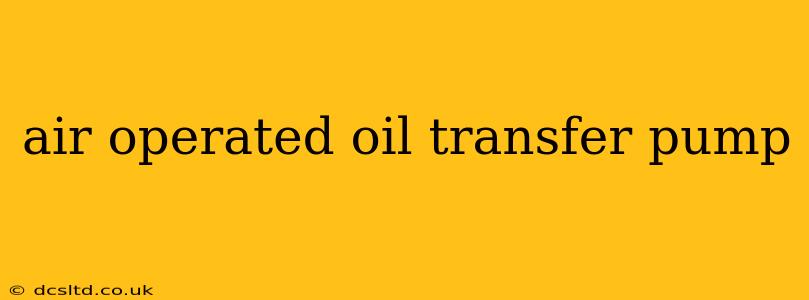Air operated oil transfer pumps are indispensable tools across various industries, offering a safe and efficient method for transferring a wide range of oils and other fluids. Their pneumatic operation eliminates the need for electricity, making them ideal for hazardous environments or locations without power access. This comprehensive guide explores the intricacies of these pumps, answering frequently asked questions and providing valuable insights for users and potential buyers.
What are the advantages of using an air-operated oil transfer pump?
Air operated oil transfer pumps offer several key advantages over other pump types:
- Safety: Their pneumatic operation eliminates the risk of electrical sparks, making them suitable for potentially explosive environments. The absence of electrical components reduces the chance of equipment malfunction due to power surges or failures.
- Portability: These pumps are generally lightweight and compact, facilitating easy transportation and use in diverse locations. Their self-contained nature simplifies setup and operation.
- Versatility: They can handle a variety of fluids, including oils, lubricants, and other viscous liquids, making them adaptable to various applications. Many models are available to handle different viscosities and pressures.
- Maintenance: Air operated pumps typically require less maintenance compared to electric pumps, reducing downtime and operational costs.
- Cost-effectiveness: The initial investment is often lower than that of electric pumps, particularly when considering long-term maintenance costs.
What are the different types of air-operated oil transfer pumps?
Several types of air-operated oil transfer pumps cater to various needs and applications:
- Diaphragm Pumps: These pumps use a flexible diaphragm to displace fluid, making them suitable for handling abrasive or viscous fluids. They're known for their self-priming capabilities and gentle fluid handling.
- Piston Pumps: Piston pumps offer higher pressure and flow rates compared to diaphragm pumps, ideal for transferring large volumes of oil quickly. However, they may be less suitable for highly viscous fluids.
- Rotary Pumps: Rotary pumps utilize rotating elements to move fluid, offering high flow rates and efficient operation. They are often chosen for high-volume applications.
How do I choose the right air-operated oil transfer pump for my needs?
Selecting the right air-operated oil transfer pump requires careful consideration of several factors:
- Fluid Viscosity: The pump's capacity to handle the viscosity of your specific oil is paramount. Consult the manufacturer's specifications to ensure compatibility.
- Flow Rate: Determine the required volume of oil to be transferred per unit of time. This will dictate the pump's necessary flow rate capacity.
- Pressure Requirements: The pressure needed to overcome system resistance (e.g., hose length, elevation changes) must be considered when selecting a pump.
- Materials of Construction: The pump's materials should be compatible with the oil being transferred to prevent corrosion or degradation. Consider chemical compatibility.
- Air Supply: Ensure you have an adequate air compressor to power the pump effectively. The compressor's capacity should meet or exceed the pump's air consumption requirements.
What are some common applications for air-operated oil transfer pumps?
Air-operated oil transfer pumps find applications in a wide range of industries and settings:
- Automotive Repair Shops: Transferring engine oil, transmission fluid, and other lubricants.
- Industrial Maintenance: Transferring lubricating oils and hydraulic fluids in machinery.
- Manufacturing Plants: Handling various oils and chemicals in production processes.
- Construction Sites: Transferring fuel and lubricants for equipment.
- Agricultural Settings: Transferring oils and fuels for farm machinery.
How much does an air-operated oil transfer pump cost?
The cost of an air-operated oil transfer pump varies considerably depending on factors like capacity, features, and brand. Prices range from a few hundred dollars for basic models to several thousand dollars for heavy-duty, high-capacity pumps. It's best to obtain quotes from various suppliers to compare pricing and features.
What is the maintenance schedule for an air-operated oil transfer pump?
Regular maintenance is crucial for extending the lifespan and ensuring efficient operation of your air-operated oil transfer pump. This typically includes:
- Regular Inspection: Check for leaks, wear, and tear on hoses, connections, and pump components.
- Lubrication: Lubricate moving parts as recommended by the manufacturer.
- Filter Changes: Replace air filters and fluid filters as needed to prevent contamination.
- Air Line Maintenance: Keep air lines clean and free of obstructions.
By following these guidelines and understanding the nuances of air-operated oil transfer pumps, you can select and maintain the right equipment for your specific needs, ensuring efficient and safe fluid transfer operations. Remember to always consult the manufacturer's instructions for specific maintenance and operation recommendations.
